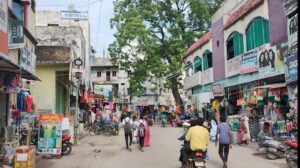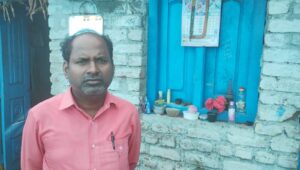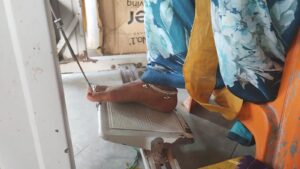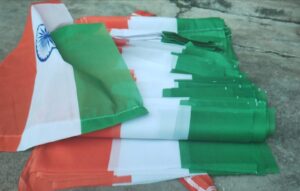Despite Independence Day being a symbol of hope for the Indian populace, it is nothing but a means to temporarily make ends meet for others.
Published Aug 15, 2024 | 9:00 AM ⚊ Updated Aug 15, 2024 | 9:00 AM

Even as the "Har Ghar Tiranga' campaign is gathering momentum, there is little excitement among those who stitch flags in Sircilla.
As Independence Day approaches, governments nationwide promote the ‘Har Ghar Tiranga’ (Tricolour in every home) campaign. The Union government is encouraging all households to hoist a flag to celebrate India’s independence.
While the streets of most cities and towns are filled with patriotic enthusiasm, the tricolour waving away in glory, the roads of Sircilla echo with a different sound.
Entering this town in the Rajanna Sircilla district, one is treated to a bustling town full of shops. However, stepping away from the streets of Sircilla the traveller is welcomed by a low humdrum of machines.
Near Sircilla’s old bus stop, every other house has a power loom, like it’s a daily appliance. Yet, in Sircilla, a town with 5.5 lakh population, it virtually is. The town is popular in Telangana under the moniker of the Textile Town.

In Sircilla, away from the lively shops and crowd lie numerous power looms in every house
Stepping into the inner parts of Sircilla, one would be pressed to spot a two-storeyed building. Most of the houses in these parts are old, with low-rise roofs.
In one such house near Ganesh Nagar in Sircilla, Y Satyanarayana, a weaver, lives with his family working on the national flags.
“We do not get work around the year. We are in demand only around August or during election time,” Satyanarayana revealed. His family used to run a power loom in 2020 before they shut it down due to losses.
“When you run a power loom, you need to make at least ₹1,000 per day to break even. We barely got ₹400-₹600 even on a good day. Eventually, the losses made us close it down,” he recounted.

Y Satyanarayana has lived in Sircilla for over 40 years. Before the 2020 lockdown, he owned a power loom
Satyanrayana has been in Sircilla for over 40 years since the 1980s, a time which he fondly remembers.
“We started stitching flags since the Covid-19 lockdown in 2020. None of us could go anywhere and we got the offer to stitch flags. We needed the money so we took it on,” he said.
However, things have counterintuitively gotten worse since the lockdown. While they were initially paid ₹1 per flag, this payment was soon halved.
“Ideally, we should be receiving ₹2 per flag for this to be a viable source of income. Currently, we get paid 50 paise,” he lamented.
Along with his family, Satyanarayana stitches about 1,000 flags a day. He divides these 1,000 flags into bundles of 100.
“It takes us about two hours to complete a bundle, we cannot do more than 10 a day. On most days we even fall short of 10. At the end, we get ₹500 for all the work we put in,” he stated. Satyanarayan also pointed out that they had to purchase spools of thread out of their own pocket, further denting their income.

Satyanarayana’s wife stitches hundreds of flags for hours together at ₹0.5 per flag
“We simply stitch the piece of cloth that the manufacturers provide to us. They give us dyed flags and we stitch it to make them ready for a flagpole or flagstaff,” Satyanarayana said.
However, he is suspicious of the cash flow in the trade. He noted that there is no transparency in the trade. “We don’t know how much they get the cloth for or at what price they sell it. All we know is that we get a meagre 50 paise per flag,” he said.

Satyanarayana’s family gets ₹50 for every bundle of 100 flags they stitch
Adding that the exponential profits solely belong to the manufacturers and middlemen, he predicted that none of them would be willing to speak with the media or talk about their operations.
Interestingly, Satyanarayana’s predictions turned true as none of the manufacturers allowed South First to enter their facilities or ask about their operations.
“I understand the relevance of the story, but neither will we talk about it nor will we let you into the facility,” a manufacturer exclaimed.
The same government that is pushing every household to hoist a flag is also pushing aside the needs of those who stitch the flags.
Despite Independence Day being a symbol of hope for the Indian populace, it is nothing but a means to temporarily make ends meet for others.
(South First is now on WhatsApp and Telegram)
